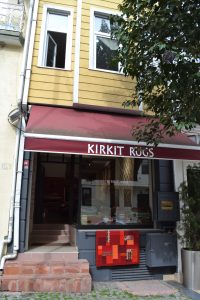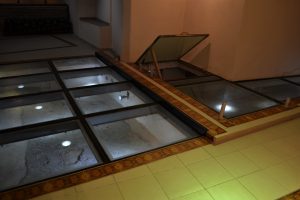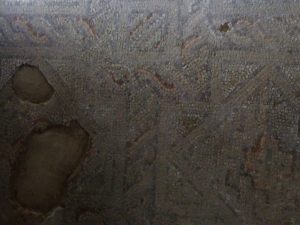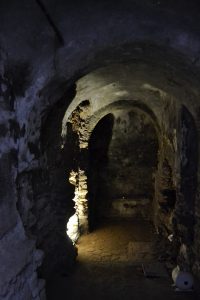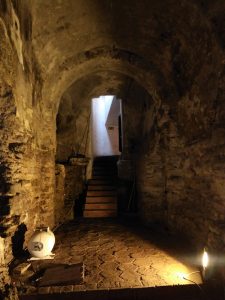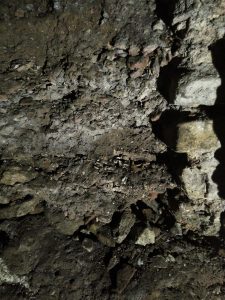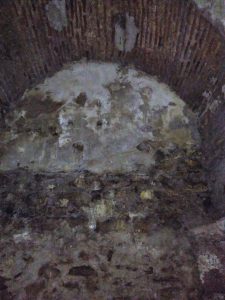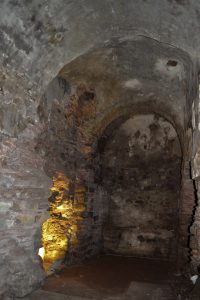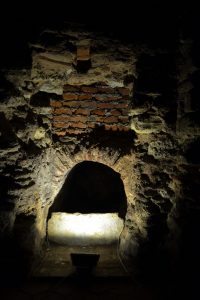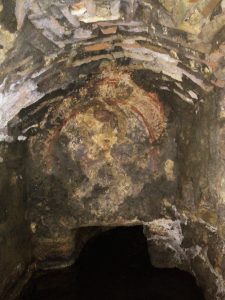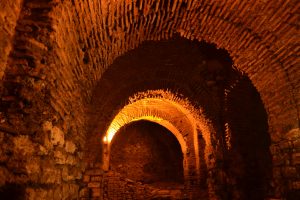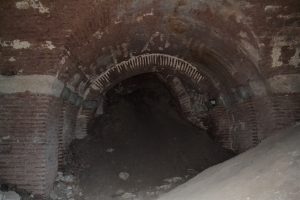These remains are under Kirkit Rugs, one of the ever-changing roster of tourist-oriented businesses that have inhabited this building for the past few decades. The previous incarnation, Sedir Carpets, has some spectacularly bad online reviews. The current proprieter is accustomed to people coming in and wanting to look at the mosaics and vault.
As with so many underground bits between the Hippodrome and the Marmara, nobody knows what this particular building (41.004668, 28.979834) was. It is in a basement area of the great jigsaw puzzle that remains of the Grand Palace. The presence of an ayazma and the fresco of the Hodegetria provide evidence that this building once served a religious function. The site was excavated by a team from Istanbul Archaeological Museum in 1997 – 98.
One descends a flight of stairs to a travel company with an entrance from Amiral Tafdil Sokak. Here, someone will point out an iron door and let you through if it has not already been opened. Alternatively, you may see some Byzantine wall fragments if you open a door that leads you outside to the north of the building.
After some more steps down, one reaches a room where some wall fragments have been preserved and where most of the floor is covered with an illuminated glass covering. This protects an expanse of mosaic floor which may or may not be associated with the vaulted ayazma below.
From the mosaic, another flight of stairs leads down to the single vault. This structure, with blind arches at each end, was once covered with fresco, most of which is gone. This site does not seem to follow the usual rule of layers going from oldest at the bottom to more recent as ground level is approached. The recessed brick technique in the vault is similar to that used in the churches of the Pantocrator and the Church of the Panagia Krina (Chios). This is a strong clue that the vault dates from the 11th or 12th century. Oddly, the technique of the mosaic floor stems from the 5th century, when the large, palatial rooms of the Great Palace were built. The vaults beneath these appear to be 600 years younger and have a floor level about four metres lower.
It appears that before the excavation in the late 1990s, the vault was something of a midden. The picture below shows layers of sheep bones and mussel shells.
The vault was clearly once covered in fresco decoration. Now it is very hard to see any detail at all.
What distinguishes this vault from many similar structures in subterranean Cankurtaran is the ayazma (Hagiasma) or sacred fountain .
It consists of a narrow channel flowing through the foundation and finishing with a pool housed in a barrel vault only about a metre high. There is an irregularly shaped, plain slice of marble partially covering the entrance.
The real treasure is only seen by peering into the darkness past that slab of marble. Above the channel is a lunette with a painted icon of the Theotokos with Christ Child. A partially legible Greek inscription forms an arch at the top of the fresco.
The iconography seems to resist interpretation. Some see this painting as a representation of the Panagia Hodegetria (‘She who shows the way’) with the Holy Mother holding the child and pointing to him as the way forward to salvation for all of humankind. This has led some to suggest that the vault was the site of the Monastery of Hodegetria, a location that most evidence points to as being some distance to the north-east. Others interpret the picture as evidence that this was the spring of Zoodochos Pege. This seems almost certain to be in the well-known Balikli Monastery outside the Theodosian walls near Silivrikapi. A member of the team who excavated the building suggested that this vault was part of the foundation of the famous Nea Ekklesia but the brickwork seems to be from much later than that church’s building date. It seems likely that this was an undistinguished chapel built over a little spring that surfaced in someone’s basement during the Latin occupation, or perhaps soon afterwards.
To place this vault in context, it lies not 200 metres from the major foundations associated with the Grand Palace. One of them, beneath the Palatium Restaurant (41.006248, 28.980492) is labelled as Senate House, part of Magnaura Palace. The other, beneath a car park a few metres east of the Mosaic Museum (41.004061, 28.978048) needs some subterfuge to enter.
The extent of these two sites, combined with the many other vaults and cisterns beneath almost every building in the district, shows that the below ground parts of the Grand Palace were gigantic and that large swathes of the palace are still worth exploring. Our vault beneath the carpet shop may just be a tiny chapel in an enormous, continuous block of subterranean Constantinople.
Denker, A. et al. (2015) Exhibition Catalogue. Hayat Kısa, Sanat Uzun: Bizans’ta Şifa Sanatı (Life Is Short, Art Long: The Art of Healing in Byzantium) Suna ve İnan Kıraç Vakfı Pera Müzesi. Page 71.

Categories: Uncategorized | No Comments »
